Investigation of the Magnetosphere of Ganymede with Galileo's Energetic Particle Detector
Ph.D. dissertation by Shawn M. Stone, University of Kansas,
1999.
Copyright 1999 by Shawn M. Stone. Used with permission.
4.8.3 Adding Finite Thickness to the Boundary
The thickness of the boundary can be calculated from the measured duration of the magnetopause crossing multiplied by the velocity of Galileo through the boundary (vg=8 km/s). From the magnetic field data at G2, presented in Figure 1.14, the duration of the inbound crossing is approximately 40 s, giving a thickness of about 320 km [Kivelson et al., 1998]. The boundaries presented in Table 4.10 are infinitesimally thin, since the internal field within the magnetopause boundary is turned off outside, and thickness must be added. To do this a step function of the form
|
|
[4.36] |
is imposed at the boundary where n is an arbitrary number, and r is the distance from the boundary. Figure 4.29a shows Equation [4.36] graphed for three cases, n small, n large, and n -->infinity. For small n, the step function begins a slow transition from 0 to 1 centered about r=0. For n -->infinity, Equation [4.36] becomes the Heaviside step function [Arfken, 1985] which makes the boundary infinitesimally thin. Figure 4.29b shows the boundary thickness as a function of index n which was derived from field line tracings. In this manner the thickness of the boundary can be dialed in. Figure 4.30 shows tracings from two magnetic field lines for n=15.5, which corresponds to a thickness of 400 km. Figures 4.31 to 4.34 show the magnetic field strength as a function of distance along the field line for each magnetic field component. The smooth crossing of the boundary can be seen clearly in each component, where the transition from BIM to BEM takes place.
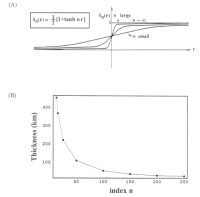 |
Figure 4.29 (A) Graph of Equation [4.36] for three cases of index n. For the case where n -->infinity [4.36] becomes the Heaviside step function [Arfkin, 1985]. (B) Graph of boundary thickness vs. index n determined from field line tracing through the boundary. |
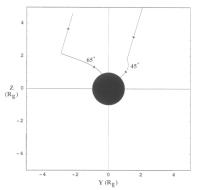 |
Figure 4.30 Magnetic field tracings at G2 for two latitudes in GSII coordinates. The 65º line traces through the tail boundary. The 45º line traces through the magnetopause boundary. |
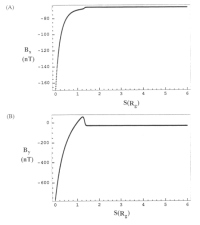 |
Figure 4.31 Results of the 45º field line trace. (A) Component Bx, as a function of distance along the field line in Ganymede radii. (B) Component By, as a function of distance along the field line in Ganymede radii. The smooth transition across the boundary from the inner field to the outer field can be seen at s=1.2 Rg. The boundary thickness is about 400 km. . |
 |
Figure 4.32 Results of the 45º field line trace. (A) Component Bz, as a function of distance along the field line in Ganymede radii. (B) Magnitude B as a function of distance along the field line in Ganymede radii. The smooth transition across the boundary from the inner field to the outer field can be seen at s=1.2 Rg. The boundary thickness is about 400 km. . |
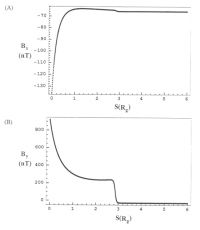 |
Figure 4.33 Results of the 65º field line trace. (A) Component Bx, as a function of distance along the field line in Ganymede radii. (B) Component By as a function of distance along the field line in Ganymede radii. The smooth transition across the boundary from the inner field to the outer field can be seen at s=2.9 Rg. The boundary thickness is about 400 km. |
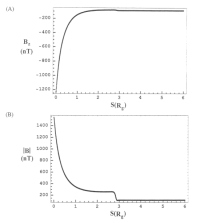 |
Figure 4.34 Results of the 65º field line trace. (A) Component Bz, as a function of distance along the field line in Ganymede radii. (B) Magnitude B as a function of distance along the field line in Ganymede radii. The smooth transition across the boundary from the inner field to the outer field can be seen at s=2.9 Rg. The boundary thickness is about 400 km. |
Next: 4.9 The Divergence of Magnetic Field in Models M1 and M2
Return to dissertation table of contents page.
Return to main
Galileo Table of Contents Page.
Return to Fundamental
Technologies Home Page.
Updated 8/23/19, Cameron Crane
QUICK FACTS
Mission Duration: Galileo was planned to have a mission duration of around 8 years, but was kept in operation for 13 years, 11 months, and 3 days, until it was destroyed in a controlled impact with Jupiter on September 21, 2003.
Destination: Galileo's destination was Jupiter and its moons, which it orbitted for 7 years, 9 months, and 13 days.




